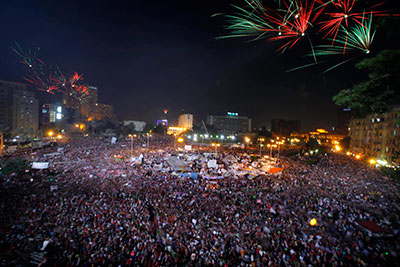From São Paulo to Istanbul to Cairo, coverage of street demonstrations has re-emerged as an exceptionally dangerous assignment for journalists. Since June 1, CPJ has documented more than 120 attacks on the press amid the civil unrest in Brazil, Turkey, and Egypt–the biggest surge of attacks in such circumstances since the uprisings that swept the Arab world in 2011. My colleague Özgür Öğret described the danger in Turkish streets last week, and CPJ issued several alerts on assaults on the press in Brazil. The massive protests in Egypt have already resulted in more than three dozen anti-press attacks, including one fatality, and bring to mind the record-setting violence of two years ago.
Salah al-Din Hassan, an Egyptian reporter for the website Shaab Masr, died Saturday when a homemade bomb thrown by an unidentified assailant exploded during an anti-government protest in Port Said. In separate anti-press episodes, assailants threw Molotov cocktails, destroyed equipment, fired live ammunition and rubber bullets, and used sticks, rods, and fists against reporters. One local journalist was abducted and likely tortured by his captors.
International outlets working in Egypt reported being harassed and obstructed. Fox Business Network’s Ashley Webster said unidentified security agents burst into his hotel room and forced a cameraman off the balcony from which he was filming. Both pro- and anti-government protesters attacked a Fox News TV crew in Tahrir Square, according to reporter Greg Palkot. He said other protesters intervened to help the crew escape down an alley into a hotel.
While CPJ has documented 125 anti-press attacks in Egypt, Brazil, and Turkey since June 1, the actual number is certainly higher: CPJ’s figures are based only on information the organization has been able to verify. Cases include assaults, obstruction, detention, raids, threats, censorship orders, and confiscation or destruction of equipment. At least 59 cases have been reported in Turkey, 37 in Egypt, and 29 in Brazil. The surge in attacks related to street protests bring to mind 2011, which set a record in CPJ’s 32-year history. Our organization was documenting dozens of cases daily at the height of the 2011 unrest.
The renewed street violence poses great challenges for journalists. As I described in the CPJ Journalist Security Guide, published last year, journalists should position themselves out of the line of fire from any hostile side; they should work in teams with at one person watching for projectiles and other hazards; and they should avoid circumstances in which an individual reporter, woman or man, can be surrounded or cornered by a hostile group.
Possible incendiary devices should always be considered to be a live explosive and should not be handled. Protective head gear and anti-stab vests may also be warranted. As the last two years shows, covering civil unrest is among the most dangerous assignments any reporter can have.
CPJ’s Journalist Security Guide covers a range of threats and is published in English, Arabic, Spanish, French, and Somali.
UPDATE: The original text of this blog has been corrected to reflect that a Dutch woman who was sexually assaulted in Tahrir Square was not a journalist, according to Dutch officials.
